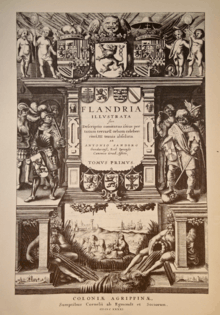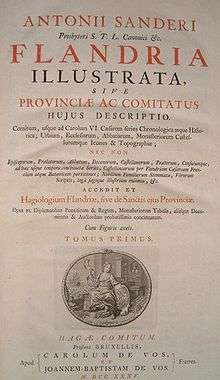Flandria Illustrata
Flandria Illustrata is a historiographical and cartographic work from 1641 by the Flemish canon Antonius Sanderus. It contains descriptions of the main towns and villages of the former county of Flanders, in addition to a description of its counts and bishops. Often a map or drawing of a city or village is added. The work had several editions in 1735 and was also published in Dutch under the title Verheerlykt Vlaandre.


Sanderus' predecessors
Sanderus tells us in his Sanderus Apologidion that the biggest inspiration for his Flandria Illustrata was the Theatrum sive Hollandiae Comitatus et urbium nova descriptio Marcus Zuerius Boxhornius (Boxhorn Nl), which in 1632 was published by the Amsterdam publisher and engraver Henricus Hondius. This led Sanderus to join the revival of history and cartography that was going on since the 16th century. It was Sanderus' goal to surpass his predecessors, both in terms of completeness and quality.
Publication
The writing and publishing of Flandria Illustrata did not run without a hitch. After the plan was conceived, Sanderus contacted the North Dutch publisher Henricus Hondius, who also published the work of Boxhorn. All this ran through his contacts with a middleman, Johannes D'Hondt, a nephew of Henry and a knowledge also of the family Sanderus. There was one major problem: Henricus Hondius, as a North Dutchman, was a Protestant. The Catholic Church had a habit of publishing books in Protestant countries without the index to places. This would mean not only that the book would be almost unobtainable in Flanders, but that it would portray Sanderus, a canon, in a bad light. The Dutch publishers had already found solution to this problem: the book was printed by a Dutch printing company, but under the name of a Catholic publisher from Cologne.
From 1632 Sanderus began with the first studies for his work. In 1634 he signed a contract with Hondius. After some time came, however, tensions arose: Hondius had begun his work with the material he already received, but had to constantly stop because a number of articles and drawings were always omitted. Hondius himself remained not free from blame: he sent back several drawings and cards for unnecessary corrections while failing to implement the corrections that Sanderus suggested. Hondius was so thoroughly tired of the situation in 1641 that he published Flandria Illustrata without notifying Sanderus that his nephew Johannes had sold to its competitor, the brothers Blaeu. Meanwhile the publication already advanced fairly well. Although the original proposed date was Easter 1637, the publication was completed on 1 April 1641.
References
External links
![]()